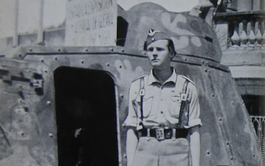Today is the 110th anniversary of the birth of a former Spectator correspondent who took part in and survived more wars than any other English writer in modern history. Yet he is practically forgotten today because he fought all his life for unfashionable conservative causes.
Peter Kemp, the son of a judge in the Indian Raj, was born in Bombay on 19 August 1915. Educated at Wellington, and destined for the law like his father, he went up to Trinity College, Cambridge, the alma mater of the notorious Communist sympathising Soviet spies Kim Philby, Guy Burgess and Anthony Blunt.
He remained utterly unashamed of having chosen the ‘wrong’ side in Spain and was proud of fighting for Franco
Kemp gravitated to the polar opposite of his leftist contemporaries and became a right-wing Tory. As such, he abandoned his studies and determined to fight for the Nationalist side in the Spanish civil war when it broke out in the summer of 1936. Pretending to be a journalist, he obtained a press pass as a correspondent for the Sunday Dispatch newspaper, and entered the war-torn country from Portugal.
Disliking the Falange, the Spanish fascist party, Kemp preferred to enlist in the cavalry of the Carlists, a monarchist faction noted for their staunch Catholicism and bravery in battle. But however romantic, these horse soldiers weren’t of much use in modern warfare, and Kemp was thirsting for action, so he transferred to the Spanish Legion – the Iberian version of the French Foreign Legion – a brutal and tough outfit whose motto was ‘Viva la Muerte!’ (Long live death!)
The Legion gave Kemp invaluable experience in the savage realities of modern warfare.
Fighting alongside the Moors who were the mainstays of General Franco’s army in the battles for control of Madrid’s university city, Kemp was kept awake all night by the screams of a captured Republican militiaman being tortured to death by his Moorish comrades in a neighbouring lecture hall.
Another time, Kemp unsuccessfully pleaded for the life of a fellow Briton, a member of the International Brigades from Belfast, but was ordered to command the firing squad at his execution instead. Wounded on several occasions, and promoted to command a whole bandera (battalion) aged only 24 – an unusual honour for a foreigner – the Spanish war ended for Kemp when his jaw was shattered and his hands were crippled by an exploding mortar bomb.
The outbreak of the second world war saved Kemp from the humdrum boredom of peace, and he lost no time in signing up for a special force, the precursor of the Special Operations Executive (SOE), specialising in cross-Channel raids on isolated Nazi outposts in France. On one such raid, Operation Dryad, Kemp took a group of Germans prisoner who were garrisoning a lighthouse off Alderney.
His next SOE assignment was to parachute into Axis-occupied Albania in support of partisans supposedly struggling to liberate their homeland. But these guerilla bands were divided between nationalists and communists and Kemp’s anti-communist convictions were reinforced when he realised they preferred to fight their rival compatriots rather than the Nazi and fascist enemy.
Kemp collided once more against his lifelong communist foes on his next mission when he was dropped into Poland to help the anti-communist home army in the 1944 Warsaw uprising against the Nazis. After the rising was crushed – partly because Stalin refused to let the Red Army intervene – Kemp surrendered to the Russian ‘allies’ but found himself in Moscow, imprisoned and interrogated by the notorious NKVD, Stalin’s murderous secret police.
He was finally freed after several months and ended the war in Indochina helping France against the VietMinh communist revolutionaries. By now, Kemp was a hardened Cold Warrior, and as that global ideological struggle began, he found himself again and again battling his old Red enemies.
He was in Budapest in 1956 when Russian tanks put down the anti-communist revolution there and he helped smuggle young Hungarian rebels to safety in Austria; and he was present in the Congo in 1960 as that vast country gained independence from Belgium while dissolving in chaotic civil strife. It was in Africa that Kemp became a special correspondent for The Spectator.
In the 1970s, The Spectator’s editor, Alexander Chancellor, was persuaded, despite his liberal tendencies, to employ the old warrior (who had passed his pensionable age) as a special correspondent in Rhodesia to report on the bitter bush war between the minority white regime of Ian Smith and Robert Mugabe’s black guerilla army. As might be expected, Kemp’s sympathies lay with the embattled Smith regime, but he continued to file insightful pieces sporadically until the Lancaster House agreement ended the conflict in 1979.
In 1957 Kemp had discovered his gift for writing when he published Mine Were of Trouble – a vivid memoir of his time in Spain and the first in an autobiographical trilogy covering his eventful life. He remained utterly unashamed of having chosen the ‘wrong’ side in Spain and was proud of fighting for Franco. He continued to believe that it was the Basques themselves rather than the Nazi Condor Legion aircraft who had destroyed the ancient Basque capital of Guernica.
Intrigued by an article by Kemp in a History magazine frankly titled ‘Why I fought for Franco’ I sought an interview with him in the 1980s. Given his amazing military record I was expecting a fire breathing volcano but was surprised and impressed by his gentleness of manner. For someone who had spent so long in situations of extreme violence, he exuded a calming sense of peace.
Even in old age, Peter Kemp couldn’t resist a final campaign and his last battle, when he was already in his 70s, was on the side of the anti-communist Contras in Nicaragua. He died in October 1993 – an unfashionable hero to the last.
Peter Kemp wrote for The Spectator about meeting Franco in 1975.







Comments